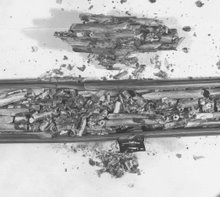 The Experimental Boiling Water Reactor (EBWR) operated at the Argonne National Laboratory during the late 1950s. The uranium fuel plates were clad with zirconium as illustrated in the drawing above. The adjacent photograph shows the fouling on a part of a fuel plate that was removed for destructive examination after about two years of service. The fuel plates became fouled with a mixture of aluminum and iron oxides. The source of the aluminum oxide was corrosion of aluminum filler pieces that were included in the structure of the reactor core. The thickness of the fouling ranged from 120 to greater than 200 microns. Of course, this fouling led to substantially higher fuel temperatures and this prevented extended operation of the EBWR at higher power levels. In general the impact of the fouling was only marginally considered and it was never included in evaluating the potential severity of accidents.
The Experimental Boiling Water Reactor (EBWR) operated at the Argonne National Laboratory during the late 1950s. The uranium fuel plates were clad with zirconium as illustrated in the drawing above. The adjacent photograph shows the fouling on a part of a fuel plate that was removed for destructive examination after about two years of service. The fuel plates became fouled with a mixture of aluminum and iron oxides. The source of the aluminum oxide was corrosion of aluminum filler pieces that were included in the structure of the reactor core. The thickness of the fouling ranged from 120 to greater than 200 microns. Of course, this fouling led to substantially higher fuel temperatures and this prevented extended operation of the EBWR at higher power levels. In general the impact of the fouling was only marginally considered and it was never included in evaluating the potential severity of accidents.I'll have more to report, including on impact of fouling by aluminum oxide on the severity of the SL-1 Accident that I briefly discussed in my entry of December 27, 2006.

No comments:
Post a Comment